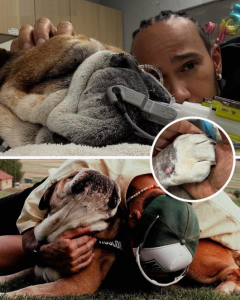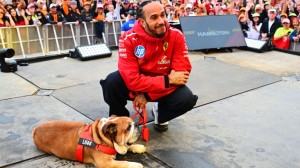
Lewis Hamilton, the seven-time Formula 1 world champion, is no stranger to victory and loss on the racetrack. But in late September 2025, the 40-year-old Briton faced a heartbreak that transcended sport — the death of his beloved bulldog, Roscoe. For more than a decade, Roscoe had been Hamilton’s faithful companion, joining him at races, photo shoots, and countless travels across the globe. Their bond was one of the most visible and genuine relationships between a sports icon and his pet. When news broke that Roscoe had passed away, tributes flooded social media from fans, fellow drivers, and teams around the world.
Hamilton adopted Roscoe in 2013, alongside his other bulldog, Coco, who passed away in 2020. Roscoe quickly became a familiar figure in the paddock — with his sturdy frame, wrinkled face, and playful charm, he was loved not only by Hamilton but also by fans and team members alike. The duo was inseparable. Whether Hamilton was flying to a Grand Prix weekend or taking time off to train, Roscoe was often seen by his side. He had his own Instagram account with over a million followers, where fans could see glimpses of his luxurious yet love-filled life — lounging in private jets, walking through race garages, or playing at home.
Hamilton’s deep affection for Roscoe reflected his broader love for animals. As an outspoken advocate for animal rights and a vegan lifestyle, Hamilton had even transitioned Roscoe to a plant-based diet. The driver often shared that Roscoe’s health improved significantly after the switch — he could breathe more easily, had more energy, and seemed happier overall. Roscoe was more than a pet; he was a symbol of Hamilton’s values — compassion, kindness, and commitment to living consciously.
In late September 2025, Hamilton posted an emotional update revealing that Roscoe had fallen seriously ill. The bulldog had developed pneumonia, and his condition deteriorated quickly. Hamilton, who had been preparing for a test session in Italy, immediately withdrew to stay with Roscoe during his treatment. The Formula 1 community, known for its intense schedule and pressure, paused as fans sent messages of support to the champion. Sadly, Roscoe’s condition worsened. During sedation, his heart stopped, and though veterinarians managed to revive him, he slipped into a coma. After four days on life support, Hamilton faced the painful decision no pet owner ever wants to make — to let Roscoe go peacefully.
Hamilton announced Roscoe’s passing with a heartfelt tribute on Instagram. He wrote, “After four days on life support, fighting with every bit of strength he had, I had to make the hardest decision of my life and say goodbye to Roscoe. He never stopped fighting until the very end. He was my best friend, my companion, my happiness. I’ll forever cherish the memories we made together.” His message struck a chord across the world, with hundreds of thousands of fans expressing condolences. Formula 1 teams, including Ferrari and Mercedes, posted tributes, calling Roscoe a “true paddock legend” who brought warmth to every race he attended.
The pain was especially raw because Hamilton had already experienced a similar loss five years earlier when Coco, Roscoe’s companion, died unexpectedly from a heart attack. In both cases, Hamilton’s openness about his grief resonated with millions of people who have loved and lost pets. “It is one of the most painful experiences,” he said in a statement, “and I feel a deep connection to everyone who has gone through the loss of a beloved pet. Although it was so hard, having him was one of the most beautiful parts of life — to love so deeply and to be loved in return.”
Roscoe’s presence had become a fixture in Formula 1 culture. Reporters often captured moments of him trotting alongside Hamilton, greeting fans with calm curiosity, or napping near the team garage. He wasn’t just a mascot; he was a symbol of balance in Hamilton’s fast-paced life. In interviews, Hamilton often mentioned that Roscoe helped him cope with the mental pressures of competition. “He always brought me peace,” Hamilton once said. “No matter what was happening in the world, when I came home to him, I was grounded.” That serenity and sense of grounding will be difficult to replace.
Roscoe’s loss comes during a pivotal period in Hamilton’s career. Having joined Ferrari after years of dominance with Mercedes, he is chasing what could be an eighth world championship — a record that would solidify his place as the most successful driver in Formula 1 history. Yet, amid all the intensity and ambition, this moment reminds fans and fellow competitors that behind the helmet and records is a human being capable of deep love and vulnerability. Hamilton’s willingness to share his grief publicly has brought out widespread admiration and empathy.
In the days following Roscoe’s death, Hamilton paid tribute in another touching way — he unveiled a LEGO portrait of Roscoe that he built himself. It showed the bulldog’s unmistakable face, capturing his wrinkles and soulful eyes in tiny colored bricks. “This is how I’ll keep him close,” Hamilton wrote. The gesture reminded fans that while Roscoe may be gone, his spirit will continue to accompany Hamilton wherever he goes — on the track, in the paddock, and beyond.
For many, Roscoe represented the softer side of a man known for speed, competition, and activism. His relationship with Hamilton was filled with affection, humor, and authenticity — qualities that made their bond universally relatable. Fans around the world posted their own pictures of dogs, writing messages such as, “Run free, Roscoe,” and “Thank you for bringing joy to so many.” Even rival drivers extended sympathy, acknowledging the emotional weight of such a loss.
Hamilton’s story with Roscoe is ultimately one of love — pure, unconditional, and enduring. It reminds us that even the most accomplished among us rely on simple sources of happiness: a loyal friend, a wagging tail, and the comfort of companionship. As Hamilton continues his journey in Formula 1, there’s little doubt that Roscoe’s memory will stay with him, perhaps giving him strength in moments of challenge. The racetrack may be filled with noise, but Roscoe’s absence will be felt in the quiet moments — when the engines stop, the cameras fade, and Hamilton returns to an empty home.
In the world of motorsport, where speed defines everything, Roscoe symbolized the opposite — stillness, love, and loyalty. He reminded fans and drivers alike that greatness isn’t only measured in victories or trophies, but also in the capacity to care deeply. As Hamilton wrote in his farewell, “You’ll always be with me, Roscoe. Thank you for filling my life with so much love.” For those who followed their journey, Roscoe’s pawprints will remain etched not only in Hamilton’s heart but also in the story of Formula 1 itself — a gentle reminder that behind every champion, there’s a loyal friend who helps them find their way home.


